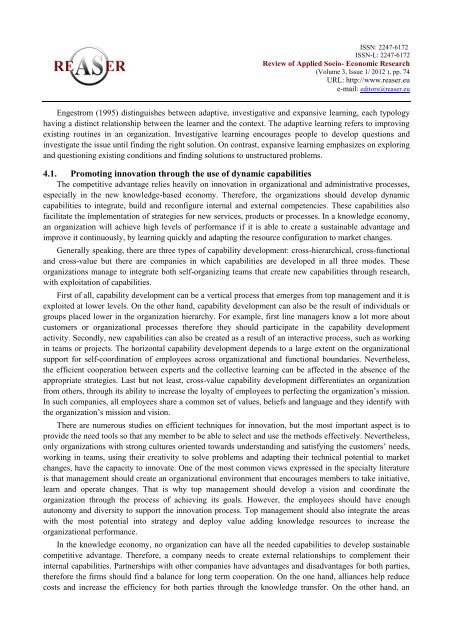Volume 3, ISSUE1/2012 - Review of Applied Socio-Economic ...
Volume 3, ISSUE1/2012 - Review of Applied Socio-Economic ...
Volume 3, ISSUE1/2012 - Review of Applied Socio-Economic ...
You also want an ePaper? Increase the reach of your titles
YUMPU automatically turns print PDFs into web optimized ePapers that Google loves.
ISSN: 2247-6172<br />
ISSN-L: 2247-6172<br />
<strong>Review</strong> <strong>of</strong> <strong>Applied</strong> <strong>Socio</strong>- <strong>Economic</strong> Research<br />
(<strong>Volume</strong> 3, Issue 1/ <strong>2012</strong> ), pp. 74<br />
URL: http://www.reaser.eu<br />
e-mail: editors@reaser.eu<br />
Engestrom (1995) distinguishes between adaptive, investigative and expansive learning, each typology<br />
having a distinct relationship between the learner and the context. The adaptive learning refers to improving<br />
existing routines in an organization. Investigative learning encourages people to develop questions and<br />
investigate the issue until finding the right solution. On contrast, expansive learning emphasizes on exploring<br />
and questioning existing conditions and finding solutions to unstructured problems.<br />
4.1. Promoting innovation through the use <strong>of</strong> dynamic capabilities<br />
The competitive advantage relies heavily on innovation in organizational and administrative processes,<br />
especially in the new knowledge-based economy. Therefore, the organizations should develop dynamic<br />
capabilities to integrate, build and reconfigure internal and external competencies. These capabilities also<br />
facilitate the implementation <strong>of</strong> strategies for new services, products or processes. In a knowledge economy,<br />
an organization will achieve high levels <strong>of</strong> performance if it is able to create a sustainable advantage and<br />
improve it continuously, by learning quickly and adapting the resource configuration to market changes.<br />
Generally speaking, there are three types <strong>of</strong> capability development: cross-hierarchical, cross-functional<br />
and cross-value but there are companies in which capabilities are developed in all three modes. These<br />
organizations manage to integrate both self-organizing teams that create new capabilities through research,<br />
with exploitation <strong>of</strong> capabilities.<br />
First <strong>of</strong> all, capability development can be a vertical process that emerges from top management and it is<br />
exploited at lower levels. On the other hand, capability development can also be the result <strong>of</strong> individuals or<br />
groups placed lower in the organization hierarchy. For example, first line managers know a lot more about<br />
customers or organizational processes therefore they should participate in the capability development<br />
activity. Secondly, new capabilities can also be created as a result <strong>of</strong> an interactive process, such as working<br />
in teams or projects. The horizontal capability development depends to a large extent on the organizational<br />
support for self-coordination <strong>of</strong> employees across organizational and functional boundaries. Nevertheless,<br />
the efficient cooperation between experts and the collective learning can be affected in the absence <strong>of</strong> the<br />
appropriate strategies. Last but not least, cross-value capability development differentiates an organization<br />
from others, through its ability to increase the loyalty <strong>of</strong> employees to perfecting the organization’s mission.<br />
In such companies, all employees share a common set <strong>of</strong> values, beliefs and language and they identify with<br />
the organization’s mission and vision.<br />
There are numerous studies on efficient techniques for innovation, but the most important aspect is to<br />
provide the need tools so that any member to be able to select and use the methods effectively. Nevertheless,<br />
only organizations with strong cultures oriented towards understanding and satisfying the customers’ needs,<br />
working in teams, using their creativity to solve problems and adapting their technical potential to market<br />
changes, have the capacity to innovate. One <strong>of</strong> the most common views expressed in the specialty literature<br />
is that management should create an organizational environment that encourages members to take initiative,<br />
learn and operate changes. That is why top management should develop a vision and coordinate the<br />
organization through the process <strong>of</strong> achieving its goals. However, the employees should have enough<br />
autonomy and diversity to support the innovation process. Top management should also integrate the areas<br />
with the most potential into strategy and deploy value adding knowledge resources to increase the<br />
organizational performance.<br />
In the knowledge economy, no organization can have all the needed capabilities to develop sustainable<br />
competitive advantage. Therefore, a company needs to create external relationships to complement their<br />
internal capabilities. Partnerships with other companies have advantages and disadvantages for both parties,<br />
therefore the firms should find a balance for long term cooperation. On the one hand, alliances help reduce<br />
costs and increase the efficiency for both parties through the knowledge transfer. On the other hand, an








